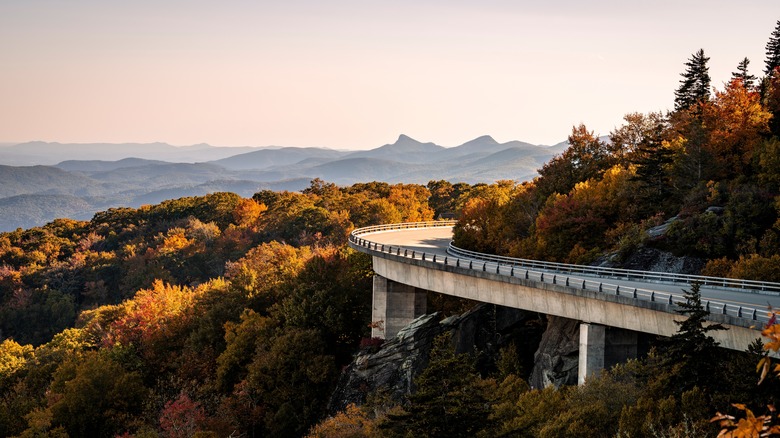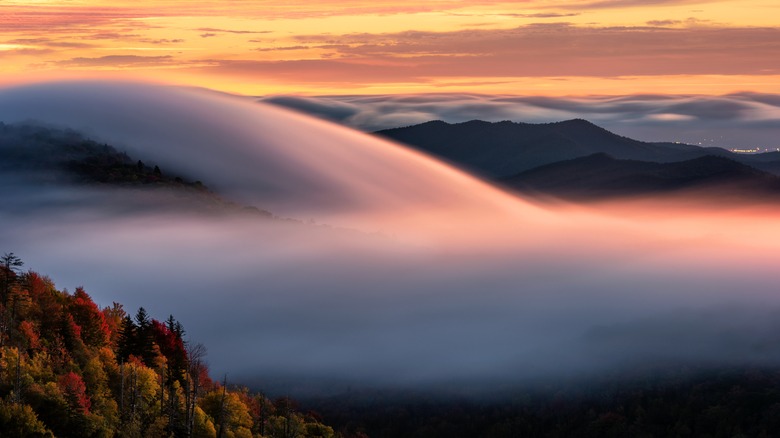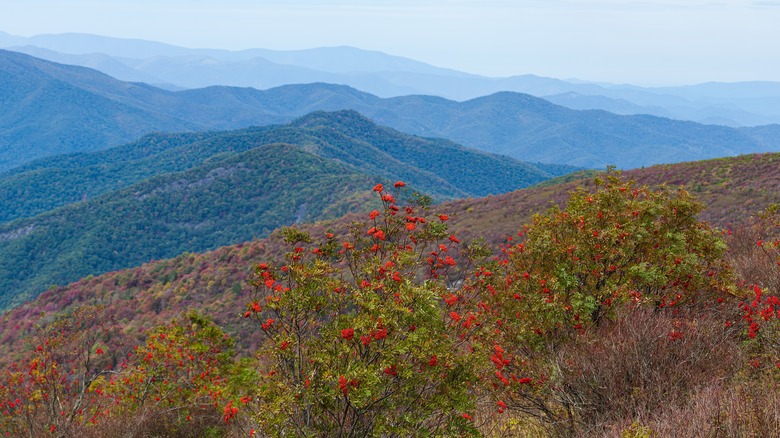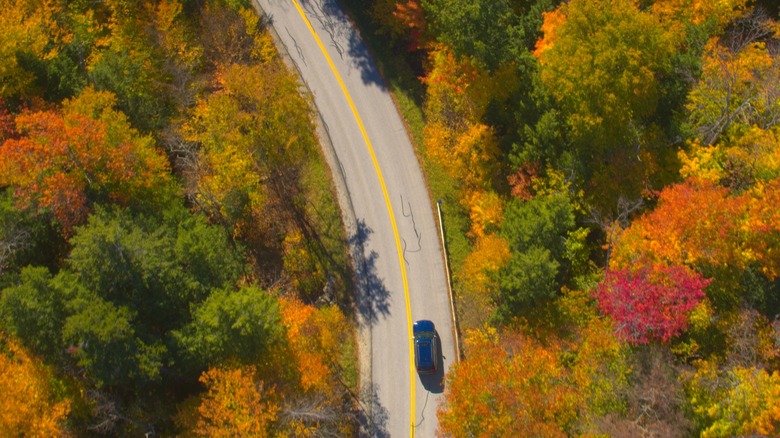This East Coast Road Called 'America's Favorite Drive' Somehow Looks Even Livelier In The Fall
America's favorite drive is The Blue Ridge Parkway. This route connects the Shenandoah National Park in Virginia to The Great Smokey Mountains National Park in North Carolina via 469 miles of meandering byway that is the very definition of a "scenic route." You could get between these two areas in under five hours on Interstate 81, but if you travel the entire length of the Blue Ridge Parkway, most people recommend around four to seven days. There are just too many beautiful things to stop and check out along the way.
Although the winter usually sees some road closures, it's still a great time to hit the parkway and pack your sled. In springtime, the drive is dotted with striking images of blooming native plants like mountain laurel. In the summer, the parkway provides plenty of spots to help you beat the heat. However, the Blue Ridge Parkway truly comes alive in the fall, when the leaves change color and create a constantly evolving galaxy of fall foliage. There's just nothing quite like driving down this road in October. The air is fresh, you can smell the changing season, and the parkway weaves directly underneath the colorful action. Now and then, you can stop at a scenic overlook and check out sweeping views of the Blue Ridge Mountains turned autumnal with leaves in all shades.
I was born and raised in North Carolina. Much of my family lived a few miles from the parkway in Saluda, and I went to school in an artsy mountain town close to several iconic parkway entrance points. For my entire life, turning off the main roads and onto this parkway meant playtime, exploration, and, most importantly, rolling the windows down while the parkway shows off the best of the Blue Ridge Mountains.
The best Blue Ridge Parkway stops
Half the fun of driving along the Blue Ridge Parkway are the stops you make along the way. There are at least 200 scenic overlooks along the highway, one every 2.3 miles. That number doesn't even include all the other categories of pull-offs and hijinks possible. Almost every curve in this serpentine scenic road has a sign directing you toward greatness.It is impossible to cover all of the best stops along this parkway in one article, let alone see them all on one drive. Budget an extra day or two for your trip so you can take your time and enjoy plenty of stops to stretch your legs in the high country.
One of the most unique stops is The Altapass Apple Orchard, on milepost 328.3. This stop provides snacks for your route that you can pick fresh against a genuine Blue Ridge fall backdrop. If you miss that stock-up spot, you can also re-supply at the Poor Farmers Market in the Meadows of Dan. With submarine sandwiches, local fruits and vegetables, and Amish porch furniture, this stop is a beautiful combination: one part general store, one part restaurant, and one part historical artifact.
Another area to circle is the "Peaks of Otter" in Central Virginia. Here, you'll find a robust visitor center with local wildlife exhibits, parks, picnic tables, fishing, and short walks all centered around views of Sharp Top, Flat Top, and Harkening Hill. There are many incredible bodies of water along the route; make sure you save time for Skinny Dip Falls, a unique cascade near Asheville, and stop to soak your toes in America's founding river.
Hikes along the Blue Ridge Parkway
Along the Parkway, there are 369 miles of hiking trails that provide everything from quick driving breaks to multi-day hiking action. Turn off the parkway at the Ridge Junction overlook and check out the summit of Mount Mitchell, an area ripe with iconic hikes. An 11-minute drive from the parkway will put you in the summit parking lot, which provides handicap-accessible pathways to the highest point east of the Mississippi. Or, you can turn off at the Buck Creek Access Point and drive to the Black Mountain Crest Trailhead. This point-to-point route starts in Bowlens Creek and takes you to the Mount Mitchell summit, passing through several other 6,000-foot peaks in over 11 miles along the way.
Hiking the 1 mile to the Rough Ridge Overlook is practically an admission requirement for nearby university students. The cliff overhang makes for an incredible picture, especially in the fall. Hikers who enjoy going up will also love the Art Loeb trail, one of my favorite hiking trails in the Pisgah National Forest. The entire trail is over 30 miles long, but parkway drivers frequently hike a 1.4-mile section of the trail that connects the Blue Ridge Parkway milepost 420 to the summit of Balsom Knob.
The Blue Ridge Parkway also interacts with the Appalachian Trail and the Mountains to Sea Trail, two well-known through hikes. From the parkway, you can dip your toes onto these two longer hikes with day treks or even overnight adventures, although you cannot freely camp on the roads of the Blue Ridge Parkways. Luckily, the parkway provides eight established campgrounds along the route in gorgeous areas. Check out the Rocky Knob Recreation area on milepost 167, a low-key camping area surrounded by 4,000 acres of wilderness.
What you should know before you drive
The most important thing to understand before you drive on the Blue Ridge Parkway is that this is not your average stretch of highway. The National Park Service clarifies that the parkway was designed as a "slow, leisurely motor route," one in which most commercial vehicles aren't even permitted. The roads here are hilly, winding stretches of asphalt with blind corners and very few moments of straight-line driving. You'll encounter steeper grades and more challenging curves than on a normal highway. Plus, on a sunny Saturday in September, the sides of the road will be brimming with activity — folks stopping for pictures, parking their cars and heading in for hikes, and enjoying picnic lunches.
You'll also likely encounter wildlife, like bears, deer, and cyclists darting across the road. Drive slowly. You're expected to share the road with all walks of life and provide a wide berth. It's important to remember that these animals are wild. For your safety and theirs, it's best to observe from a distance and avoid feeding them, especially the bikers.
Most importantly, you should treat your entire drive as if you are in a national park and leave no trace. There are plenty of rest stops on the road with bathrooms and garbage receptacles. If everyone who drove down the parkway threw their banana peels out the window, it would get gross fast, so leave no trace along your entire drive to ensure everyone can enjoy one of the country's most stunning and storied routes.



